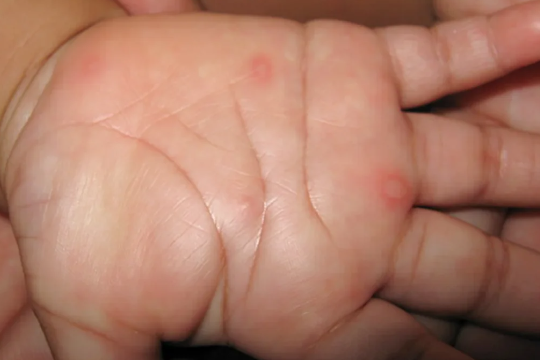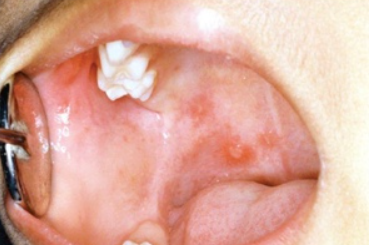Hand-foot-mouth disease is an acute self-limiting systemic viral infection characterized by generalized malaise, fever, oral mucosal erosions, and a vesicular rash on the hands and feet. ICD-10 Code: B08.4
It is most commonly caused by Coxsackievirus A16, less frequently by other Coxsackieviruses (A4, A5, A6, A7, A9, A10, B2, B5), and enterovirus EV-A71. The disease is highly contagious and spreads through respiratory droplets, nasal and oral secretions, or feces. Outbreaks usually occur between June and October. It primarily affects children under 10 years old, but adults can also be affected, although less frequently.
The virus enters the human body through the oral and anal mucosa and initially infects regional lymph nodes. After 72 hours, viremia develops, leading to the involvement of the oral mucosa and skin of the extremities.Incubation period is short, ranging from 3 to 6 days. This disease starts with mild fever, sore throat, cough, headache, general malaise, and sometimes diarrhea and joint pain. One to two days after the onset of fever, erythematous spots appear on the oral mucosa, palate, gums, tongue, and posterior pharyngeal wall, forming small, rapidly ulcerating oval or elliptical vesicles.
Later, erythematous spots with vesicles on the surface, ranging from 2 to 8 mm in diameter, appear on the palms and soles, lateral and dorsal surfaces of the fingers of the hands and feet, sometimes on the buttocks, and parallel to the skin lines on the lateral surfaces of the trunk. Perioral rash and desquamation of the palms and soles may occur in adults, and onychomadesis is rare. Enlargement of cervical and submandibular lymph nodes is observed. The rash usually resolves spontaneously within 7-10 days.
Complications may include encephalitis, interstitial pneumonia, myocarditis, meningoencephalitis, and spontaneous abortion. Complications are more common when the disease is caused by enterovirus EV-A71.- Chickenpox (Varicella)
- Dyshidrotic Eczema
- Erythema Multiforme
- Herpetic Stomatitis
- Aphthous Ulcers
- Streptococcal Infection
- Candidiasis
- Herpetic Angina
- Disseminated Herpes Simplex or Herpes Zoster
- Meningococcemia
- Rocky Mountain Spotted Fever
- Subacute Bacterial Endocarditis




